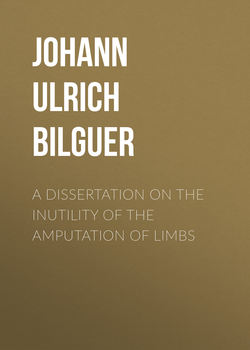Читать книгу A dissertation on the inutility of the amputation of limbs - Johann Ulrich Bilguer - Страница 12
SECT. IX
ОглавлениеAfter these incisions are made, we must carefully examine how far the part which is absolutely mortified, and which it is impossible to restore to life, may reach. This may be distinguished by the stench which exhales from it, by its change of colour, and want of feeling. These mortified parts ought immediately to be separated from the sound, and removed by means of a bistory in the same manner as one muscle is divided from another in an anatomical dissection. In order to do this, the dead flesh must be cut through cross-ways, which puts the patient to no kind of pain. But care must be taken in this operation, not to separate such parts as may be somewhat affected by the mortification, yet not totally corrupted, as it often happens, after the removal of what is entirely dead, that they recover, by proper assistance, their natural state.
In making these incisions, we should take all imaginable care, as I have already remarked, not to wound the larger blood vessels or more considerable nerves; for this purpose, the gangrened parts which lie near them, should be separated with great caution: It is even better to leave behind a small portion of the mortified flesh which may adhere to them, and to trust for its separation to the ensuing dressings, which they will not fail to accomplish. The reason for this rule is, that we often see the vessels remain sufficiently sound, while the other parts are very much corrupted. We find for example, in the arm, near the joint of the elbow, near the wrist, and even in the lower extremities, the vessels intire, although the mortification of the parts which surround them be so considerable, as to oblige us to make our incisions to the bone; and it is these vessels, after the extirpation of the dead parts, that must keep up life in those which remain: We ought to preserve the greatest number we can, not only of the larger vessels, but even of the smaller ones: It was with a view to this particular, that I recommended not to make our incisions rashly, but with a good deal of caution, both with respect to the place where they were made, their direction and their distance. In operating with this circumspection, we shall avoid incurring the censure of Platnerus, who remarks, that we ought not to separate the dead from the sound parts with violence, “Because,” says he, “incisions which cause an effusion of blood, often renew the inflammation.” Now in my method, there is neither any violence, nor incisions attended with blood.
